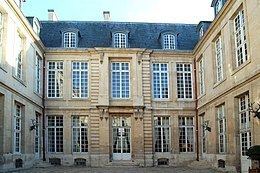Architect François Mansart | ||
 | ||
Similar Musée de la Chasse et de la N, Le Marais, Hôtel de Bourgogne, Hôtel de Rohan‑Strasbourg, Théâtre du Marais | ||
During the ancien regime there were several Hôtel de Guénégauds in Paris.
Contents
- Map of HC3B4tel GuC3A9nC3A9gaud 75003 Paris France
- 3rd arrondissement of Paris
- Htel de Nevers
- Gungaud Theatre
- References
Map of H%C3%B4tel Gu%C3%A9n%C3%A9gaud, 75003 Paris, France
3rd arrondissement of Paris
At 60, rue des Archives, this Hôtel de Guénégaud was built between 1651 and 1655 for Jean-François de Guénégaud des Brosses, secrétaire du Roi, maître des Comptes and conseiller d'État, by François Mansart (the only hôtel particulier this architect built to have fully survived). It now houses the Musée de la Chasse et de la Nature and the Club de la chasse et de la nature. It is served by the Arts et Métiers and Filles du Calvaire Metro stations.
Hôtel de Nevers
On the site of the present day Hôtel des Monnaies (1768), the Hôtel de Nevers (on the quai de Nevers, just east of the Tour de Nesle) was purchased in 1646 by Henri de Guénégaud and transformed by the architect François Mansart into the Hôtel de Guénégaud in 1648–1652. The rue Guénégaud was created on the garden side of the hôtel. In 1670 ownership of this Hôtel de Guénégaud was transferred to one of Cardinal Mazarin's nieces, Anne-Marie Martinozzi, Princesse de Conti, and it became known as the Hôtel de Conti. The quai de Nevers became the quai de Conti, but the name of the rue Guénégaud has remained unchanged up to the present day.
Guénégaud Theatre
In 1673 after the death of Molière the remnants of his company were forced to vacate their theatre in the Palais Royal. With poor prospects they merged with the players from the Théâtre du Marais and moved into a theatre on the rue des Fossés de Nesle (later the rue Mazarine), not far from the Hôtel de Conti. The theatre, previously known as the Salle de la Bouteille, a former tennis court (jeu de paume) which in 1671 had been converted into a theatre for the use of Pierre Perrin's Académie d'Opéra (see Paris Opera), became known as the Théâtre de Guénégaud. It was located just across from the end of the rue Guénégaud, which, after the demolition of the Tour de Nesle and adjacent wall of Philippe Auguste during the construction of the Collège des Quatre Nations, had been extended as far as the rue Mazarine. For some unknown reason the company also referred to the theatre as the Hôtel de Guénégaud, notwithstanding that their humble abode bore little resemblance to a grand hôtel particulier. After merging with the troupe from the Hôtel de Bourgogne in 1680, the company became known as the Comédie-Française and continued to perform in the same theatre until 18 April 1689, when it opened at the Jeu de Paume de l'Étoile on the rue des Fossés-Saint-Germain-des-Prés (the southeastward extension of the rue des Fossés de Nesle). That section of the road is now called the rue de l'Ancienne-Comédie.
